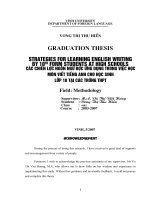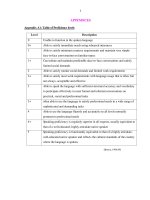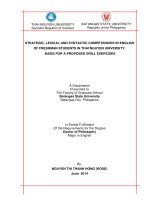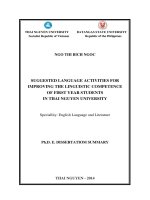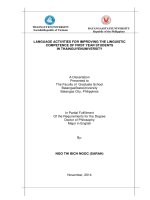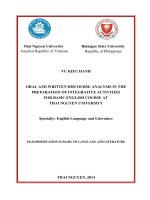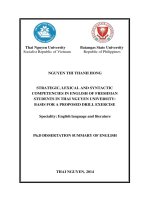An exploration of strategies for oral skills improvement by advanced program students at Thai Nguyen university of technology
Bạn đang xem bản rút gọn của tài liệu. Xem và tải ngay bản đầy đủ của tài liệu tại đây (184 KB, 6 trang )
Dương Đức Minh
Tạp chí KHOA HỌC & CÔNG NGHỆ
84(08): 123 - 128
AN EXPLORATION OF STRATEGIES FOR ORAL SKILLS IMPROVEMENT
BY ADVANCED PROGRAM STUDENTS AT THAI NGUYEN UNIVERSITY
OF TECHNOLOGY
Duong Duc Minh*
Thai Nguyen University of Technology - TNU
ABSTRACT
Research in language learning strategy has addressed the necessity of improving oral skills in
second language acquisition. This study attempts to explore strategies reported to be employed by
30 EFL advanced program students at Thai Nguyen University of Technology (TNUT) to improve
their oral skills. Semi-structured interview and open-ended questionnaire were used as the
instruments for the data collection. The data was then analyzed qualitatively for the purpose of the
study. The findings of the study showed that two main categories to improve speaking skills have
been reported included 1) fluency-focused strategies and 2) accuracy-focused strategies. Two main
categories to improve listening skill comprised 1) direct strategies and 2) indirect strategies.
Key words: oral skills improvement, language learning strategy, science-oriented students.
INTRODUCTION*
Nowadays, English has become an
international language, and it is widely used
in various areas, especially in education as
well as science and technology areas. As the
result, students have to be aware of the
necessary to employ strategies to success in
their study academically and socially.
According to Feyten (1991), of the total time
people spend on communication, 45% is on
listening, 30% on speaking, 16% on reading,
and 9% on writing [5]. Oral skills, both
speaking and listening, are at the very
foundation of literacy, and they play an
important role in the study of students, so it is
clear that oral skills have an important impact
on student's personal and professional life.
The advanced program (AP) has been put into
practice at TNUT from the academic year
2009 – 2010. In the advanced programs, all
the courses are taught in English except some
compulsory courses, e.g. Marxist – Leninism,
Physical Education, and National Defense
Education are taught in Vietnamese. At least
60% of courses are instructed by professors
from the University of New York at Buffalo
and invited professors from renowned
universities worldwide to participate in
teaching [17]. As a result, AP students are not
only required to specialize their knowledge
but also to improve their English (especially
*
Số hóa bởi Trung tâm Học liệu – Đại học Thái Nguyên
Listening, and Speaking skills) in order to
achieve greater efficiency in the learning
process at Thai Nguyen University of
Technology.
LITERATURE REVIEW
Language learning strategies (LLS) are the
behaviors or steps which an individual uses to
enhance his/her learning. The term
“strategies” which applies to language
improvement, has been developed since the
first studies by Rubin (1975) [14], Oxford
(1990) [10] and Kyong and Oxford (2008)
[6]. Examples are note taking, practicing,
finding a conversation partner, analyzing
words, using background knowledge, and
controlling anxiety. There have hundreds of
such strategies been identified. Successful
language learners use language learning
strategies that are most effective for them and
they put them together smoothly to fit the
needs of a given language task while less
successful learners are “a desperate grab-bag
of ill-matched techniques”.
In some recent years, a lot of attention has
been paid to the importance of developing
strategies in language learning. Many
research works has been conducted to
examined and explored the use of learning
strategies in the teaching and learning of
vocabulary (Brown and Perry, 1991) [2],
listening comprehension (Rossano, 1994)
[13], reading (Rusciolelli, 1995) [15], and in
the understanding of the learning process
123
Dương Đức Minh
Tạp chí KHOA HỌC & CÔNG NGHỆ
(Chamot, 2001 [3]; Nunan, 1992 [8]).
However, little research has been done on
productive skills, such as oral skills and
writing. Only few studies dealt with strategy
employed in speaking and listening, for
example, Bejarano et al (1997) examined
speaking as an interactive skill [1], and Lam
and Wong (2000) explored the importance of
oral skills in discussions [7]. No research
work has been conducted in exploring
reported strategies for oral skills improvement
by students at TNUT.
This study attempts to explore language
strategies that AP students at TNUT use in
order to improve their oral skills. In the study,
“oral skills” refer to listening and speaking
skill, the term “improvement” means to be
come better in listening and speaking and
“AP students” here are thirty students
majoring in electrical and mechanical
engineering at TNUT. Two research questions
were generated for the purpose of the study:
1) what types of strategies reported by
science-oriented graduate students for their
listening skill improvement and 2) what types
of strategies reported by science-oriented
graduate students for their speaking skill
improvement. The researchers examined a
recorded semi-structured interview of 3
students and 19 open-ended questionnaires to
collect data for the study.
METHODOLOGY
1. Participants
The participants of the present study were 30
first-year AP students at TNUT. All the
classes they have are lectured in English
except
Marxist-Leninism,
Physical
Education, and
National
Defense
Education courses are taught in Vietnamese.
At the moment, the students are studying
English from 38 to 42 periods per week. They
deal with English as a medium of instruction
to survive in their study. Among them, 3
students were purposively selected for indepth study based on their oral skills
proficiency identified by their classmates.
According to Patton (2001), a purposive
Số hóa bởi Trung tâm Học liệu – Đại học Thái Nguyên
84(08): 123 - 128
sampling is a non-random method of
sampling by which information-rich cases can
be selected for study in depth [11]. Table 1 is
the personal background information of
participants.
Table 1. The Participants’ Background
Information
Item
English Learning
Experience (years)
Self-rated for
Listening Skill
Self-rated for
Speaking Skill
Ranking
Less than 3
3-6
More than 6
Good
Fair
Poor
Good
Fair
Poor
Person(s)
1
12
6
2
15
2
2
16
1
2. Instruments
There are different methods or procedures to
collect the data in learning strategy research,
such as observation, interview, questionnaire,
verbal report, diary, and etc. Each method has
its advantage and disadvantage as well and
can be applied according to the focus of the
research. Punch (1998) points out that
different research questions required different
methods to answer them [12]. In the present
study, data collection will be conducted
through semi-structured oral interviews and
an open-ended questionnaire.
The interviews are the most widely used
method of generating data in qualitative social
research (Nunkoosing, 2005) [9]. They can be
classified into three categories ranging in
terms of their degree of formality ranging
from unstructured through semi-structured to
structured (Nunan, 1992) [8]. Of the three
types of interview, the semi-structured
interview seems to be popular among
researchers. Nunan (1992: 149) mentions
“…because of its flexibility, the semistructured interview has found favor with
many researchers, particularly those working
within an interpretative research tradition”
[8]. The most important advantage is that the
interviewer can work out a set of questions in
124
Dương Đức Minh
Tạp chí KHOA HỌC & CÔNG NGHỆ
84(08): 123 - 128
participant's own opinions on learning
strategies for oral skills improvement.
3. Data collection procedure
The data collection was divided into two
phases. One is for a questionnaire, the other is
for interviews. An open-ended questionnaire
was administered to all the participants.
However, the final sample for data analysis
consisted of 19 students. Eleven students
didn’t respond the questionnaire because they
were absent. The 3 students interviewed in
Vietnamese. The interview lasted for 20
minutes and was recorded.
4. Data analysis
The interviews’ records were fully transcribed
using verbatim and then analysed using
Strauss & Corbin’s (1998) open and axial
coding [16]. All student responses to the
open-ended questionnaire items were
collected and typed out.
RESULTS AND DISCUSSION
[1].After the carefully analysis of the
collected data from interviews and
questionnaires, there were finally 19
strategies for oral skills improvement reported
by the AP students. Strategies reported by the
AP students for their speaking skill
improvement consist of 10 strategies and 9
strategies for listening skills which will be
presented in Table 2.
advance, but be free to modify their order, to
change the way they are worked. In the
present study, the semi-structured interviews
were conducted with the participants to elicit
information and obtain in-depth perceptions
about what types of strategies they employed
for oral skills improvement. To acquire more
useful information related to the research
purposes, individual interviews were used
with audio recording.
Chamot (2001) points out that interviewees
may not report their strategy use accurately
during interview, but they may report what
they perceive as the interviewers’ preferred
answers [3]. Dornyei (2003) states that
sometimes, we need open-ended items for the
simple reason that we do not know the range
of possible answers and therefore, cannot
provide pre-prepared response categories [4].
A questionnaire with open-ended questions
would provide data that are qualitative and
exploratory in nature. To enhance data
validity in the research, an open-ended
questionnaire was employed with two main
sections. The first section is about the
individual background information, and the
second section covers open-ended questions
about strategies for oral skills improvement.
An open-ended question is designed to
encourage a full, meaningful answer using the
Table 2: Strategies for Speaking and Listening Skills Improvement Reported by the AP students
STRATEGIES FOR SPEAKING SKILL
IMPROVEMENT
1. Memorizing words / sentences / phrases to
improve one’s speaking skill
2. Communicating with other people in English
3. Imitating English native speakers
4. Trying to use English in real-life situations
5. Trying to interact with teacher in class by
asking and answering questions
6. Using the internet to improve one’s speaking
skill
7. Seeking an opportunity to speak English
8. Talking to oneself in English
9.Asking for a correction from teacher
10. Playing a speaking game in English
STRATEGIES FOR SPEAKING SKILL
IMPROVEMENT
1. Listening to radio programs in English
2. Listening to English songs
3. Watching TV programs in English
4. Watching English speaking films
5. Doing the repetitive listening
6. Using the internet to improve one’s listening skill
7. Having a conversation in English
8. Interacting with teachers in English
9. Seeking ways for improving one’s listening skill
However, the strategies for speaking and
listening skills improvement can be classified
into 2 sub-categories for each oral skill.
Số hóa bởi Trung tâm Học liệu – Đại học Thái Nguyên
Firstly, the strategies for speaking skill
improvement are categorized into (1) the
fluency-focused strategies and (2) the
125
Dương Đức Minh
Tạp chí KHOA HỌC & CÔNG NGHỆ
accuracy-focused strategies. Secondly, the
strategies for listening skill improvement are
classified into (1) the direct strategies and (2)
the indirect strategies. Table 3 presents the
classifications of the strategies for oral skills
improvement reported by the AP students.
According to strategies for speaking skill
improvement, most of the strategies reported
by the AP students were the fluency-focused
strategies (7 fluency - focused strategies out
of 10 strategies for speaking skill
improvement). Generally, the AP students are
adult learners where English is used as a
medium of instruction according to the
requirements. The possible explanation for
why the fluency-focused strategies were
mostly reported by this group of students is
that they are science-oriented students where
the focus of their study is not a language.
Instead, they have focused on contents not
language usage. Additionally, because of
English is used as a medium of instruction;
therefore, this group of students need to
84(08): 123 - 128
survive
the
program
socially
and
academically by having a good ability to
communicate in English. They need to speak
fluently to keep on their relationships and
study. They try to communicate as much as
possible. The only one goal for their speaking
at this time is that their speaking should be
understood by their interlocutors. Therefore,
most of the strategies reported by this group
of students are the fluency-focused strategies
for speaking skill improvement which they
employed to make a better or improve their
speaking skills.
However, there are some accuracy-focused
strategies reported by this group of students
for speaking skill improvement. This is
because of at some levels, accuracy is also
very important for them. For example, they
need to make a formal presentation.
Moreover, accuracy is very important for
them to write their theses, reports, or articles.
So, accuracy is also important for them if they
want to succeed in their learning.
Table 3: Classifications of Strategies for Speaking and Listening Skills Improvement
STRATEGIES FOR SPEAKING SKILL
IMPROVEMENT
The Fluency-Focused
The Accuracy- Focused
Strategies
Strategies
Communicating with other Memorizing words/
people in English
sentences / phrases to
improve one’s speaking
skill
Trying to use English in
Imitating English native
real-life situations
speakers
Trying to interact with
Asking for a correction
teacher in class by asking from teacher
and answering questions
Using the internet to improve
one’s speaking skill
Seeking an opportunity to
speak English
Talking to oneself in
English
STRATEGIES FOR LISTENING SKILL
IMPROVEMENT
The Direct Strategies
The Indirect
Strategies
Seeking ways for
improving one’s
listening skill
Listening to radio
programs in English
Listening to English
songs
Having a conversation in English
Watching TV programs Interacting with
in English
teacher in English
Watching English
speaking films
Doing the repetitive
listening
Using the internet to
improve one’s listening
skill
Playing a speaking game in
English
On the other hand, strategies for listening skill
improvement reported by the AP students
Số hóa bởi Trung tâm Học liệu – Đại học Thái Nguyên
were mostly the direct strategies (6 direct
strategies and 3 indirect strategies for
126
Dương Đức Minh
Tạp chí KHOA HỌC & CÔNG NGHỆ
84(08): 123 - 128
listening skill improvement). If we take a look
carefully to the 6 direct strategies for listening
skill improvement, we will see that all of the
direct strategies deal with mass media
communication such as news, radio,
television, and etc. This is because of, at the
present day, we are living in the technology’s
world. As a result, it is very easy for people to
listen to English radio programs, songs, or to
watch English speaking films, English news,
and etc., through the internet or satellite with
a reasonable cost. Another explanation for
why the direct strategies were mostly reported
for listening skill improvement is that in order
to practice to improve listening skill, they can
practice to improve listening skill individually
or they have no need to find out a partner or
interlocutor to interact for a listening practice.
They just find out the English programs on
the internet, radio, or television to watch and
listen. Therefore, roles of mass media in
language teaching and learning are increasing
and very important for the world today. Mass
media helps people to learn a language easily
than the past.
CONCLUSION
The AP students in the present study reported
19 strategies for oral skills improvement.
Firstly, there were 10 strategies for speaking
skill improvement reported by the AP
students which could be classified into 2 subcategories – the 7 fluency-focused strategies
and the 3 accuracy-focused strategies.
Secondly, there were 9 strategies for listening
skill improvement reported by the AP
students which could be classified into 2 subcategories – the 6 direct strategies and the 3
indirect strategies.
The AP students are adult learners who focus
their study on contents of the subject and
English is used as a medium of instruction
since this program is the international
program. All of them (19 students) are non-
English native speakers. However, although
the AP students have to use English for their
study, but the focus of their study is still on
the contents not a language usage (a content
driven not a language driven). Since English
is used as a medium of instruction, the AP
students need to learn and communicate with
their classmates and teachers in English.
Therefore, a speaking skill and a listening
skill are very important for them to survive
the program socially and academically.
The findings from the present study show that
a mass media communication or a technology
has an increasing role in language teaching
and learning nowadays. As a teacher, we
should pay more attention to a development
of technology in order to provide and prepare
ourselves for a new age of language learning
and teaching – a technology-based language
teaching and learning era. For language
learners, if they know how to use
technologies or mass media communication
effectively and maximally, it is very easy for
them to success in learning a language.
However, this study may be replicated with
the same subjects in the second academic year
of their study. Because the present study was
conducted when they are in the first semester
of the first academic year where they just
have a chance to use English or communicate
in English for a few months. So, to speak
English fluently is very important for them to
survive
the
program
socially
and
academically at this moment. But for the
second academic year, their English ability
both speaking and listening should be
improved more than this moment, therefore;
at that time these subjects may tell more
strategies about how they improve their oral
skills. This is especially for the accuracyfocused strategies to improve their oral skills
where accuracy is needed and important for
them in the future.
REFERENCES
Strategies Creating a Framework for Improved
Small-Group Communication
[1]. Bejarano, Y., T. Levine, E. Olshtain and J.
Steiner. (1997). The Skilled Use of Interaction
Số hóa bởi Trung tâm Học liệu – Đại học Thái Nguyên
127
Dương Đức Minh
Tạp chí KHOA HỌC & CÔNG NGHỆ
Interaction in the Language Classroom. System
25(2), 203-214.
[2]. Brown, T. S. &. Perry, F. L. Jr (1991). A
comparison of three learning strategies for
ESL vocabulary acquisition. TESOL Quarterly, 25
(1), 17-32
[3]. Chamot, A. U. (2001). The role of learning
strategies in second language acquisition. In M. P.
Breen (Ed.), Learner contributions to language
learning: New directions in research. Harlow:
Longman.
[4]. Dornyei, Z. (2003). Questionnaires in Second
Language
Research:
Construction,
Administration, and Processing. Mahwah:
Lawrence Erlbaum Associates, Inc., Publishers.
[5]. Feyten, C. M. (1991). The Power of Listening
Ability: An Overlooked Dimension in Language
Acquisition.The
Modern
Language
Journal 75:173-80.
[6]. Kyoung, R. L., and Oxford, R. (2008).
Understanding EFL Learners’ Strategy Use and
Strategy Awareness. Asean EFL Journal, 10(1).
[7]. Lam, W., and Wong, J. (2000). The Effects of
Strategy Training on Developing
Discussion skills in an ESL classroom. ELT
Journal. 54(3), 245-255
[8]. Nunan, D. (1992). Research methods in
language learning. Cambridge: Cambridge
University Press.
84(08): 123 - 128
[9]. Nunkoosing, K. (2005). The problems with
interviews. Qualitative Health Research, 15(5),
698-706.
[10]. Oxford, R. (1990). Language Learning
Strategies: What every teacher should know.
Boston: Heinle & Heinle.
[11]. Patton, M. (2001). Qualitative research and
evaluation methods. Thousand Oaks, CA: Sage
Publications.
[12]. Punch, K. F. (1998). Introduction to social
research:
Quantitative
and
qualitative
approaches. London: Sage Publications.
[13]. Rossano, M. J., & Hodgson, S. L. (1994).
The process of learning from small-scale maps.
Applied Cognitive Psychology, 8, 565–582
[14]. Rubin, J. (1975). What good Language
learner can teach us? TESOL Quarterly, 9(1), 4145
[15]. Rusciolelli, J. (1995), Student Responses to
Reading Strategies Instruction. Foreign Language
Annals, 28: 262–273
[16]. Strauss, A. L., & Corbin, J. (1990). Basics of
qualitative
research:
Grounded
theory,
procedures and techniques. Newbury Park: Sage.
[17]. Thainguyen University of Technology
Website. www.tnut.edu.vn. Retrieved on 20
November 2010.
TÓM TẮT
NHỮNG THỦ THUẬT PHÁT TRIỂN KỸ NĂNG GIAO TIẾP TIẾNG ANH
CỦA SINH VIÊN CHƢƠNG TRÌNH TIÊN TIẾN TẠI TRƢỜNG
ĐẠI HỌC KỸ THUẬT CÔNG NGHIỆP THÁI NGUYÊN
Dƣơng Đức Minh*
Trường Đại học Kỹ thuật công nghiệp - ĐH Thái Nguyên
Những nghiên cứu về các thủ thuật học tập trong việc học ngoại ngữ đã chỉ ra sự cần thiết của các
thủ thuật trong việc nâng cao kỹ năng nghe, nói. Nghiên cứu này sẽ khám phá, tìm hiểu các thủ
thuật để nâng cao kỹ năng nghe, nói tiếng Anh của 30 sinh viên khóa 46 chương trình tiên tiến tại
trường Đại học kỹ thuật công nghiệp Thái Nguyên. Phỏng vấn bán cấu trúc và bảng câu hỏi khảo
sát đã được sử dụng để thu thập dữ liệu. Các dữ liệu sau đó được phân tích định tính phục vụ mục
đích nghiên cứu. Kết quả nghiên cứu cho thấy:
Hai nhóm thủ thuật để nâng cao kỹ năng nói: nhóm thủ thuật tập trung vào sự lưu loát và 2) nhóm
thủ thuật tập trung vào độ chính xác.
Hai nhóm thủ thuật để nâng cao kỹ năng nghe bao gồm: 1) nhóm thủ thuật trực tiếp và 2) nhóm
thủ thuật gián tiếp.
Từ khóa: thủ thuật học tập, kỹ năng nghe, kỹ năng nói, sinh viên kỹ thuật
*
Số hóa bởi Trung tâm Học liệu – Đại học Thái Nguyên
128


